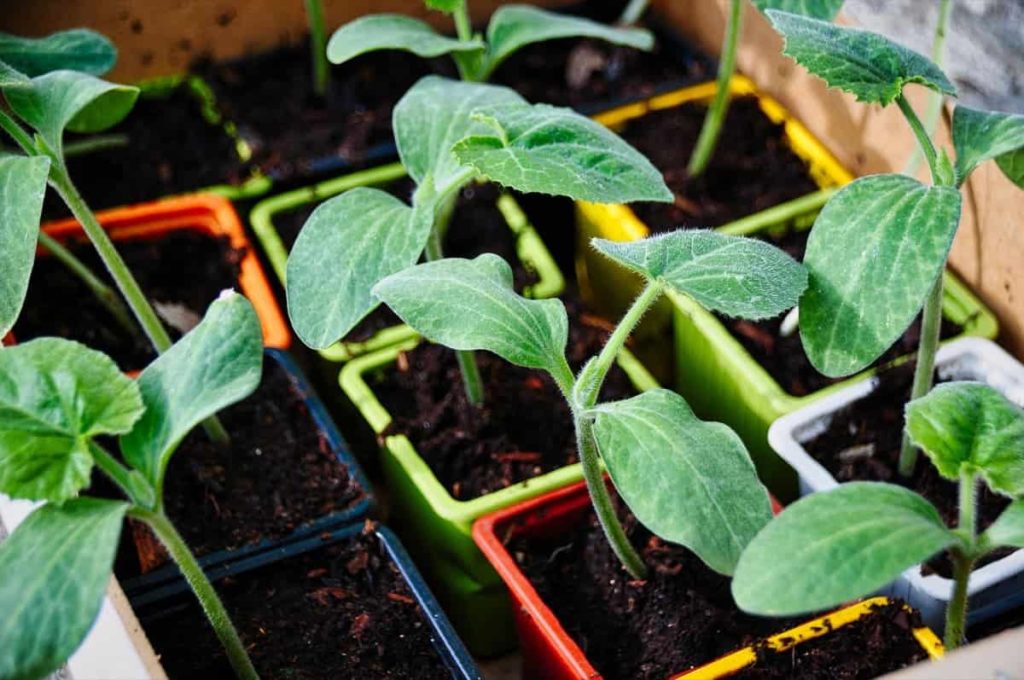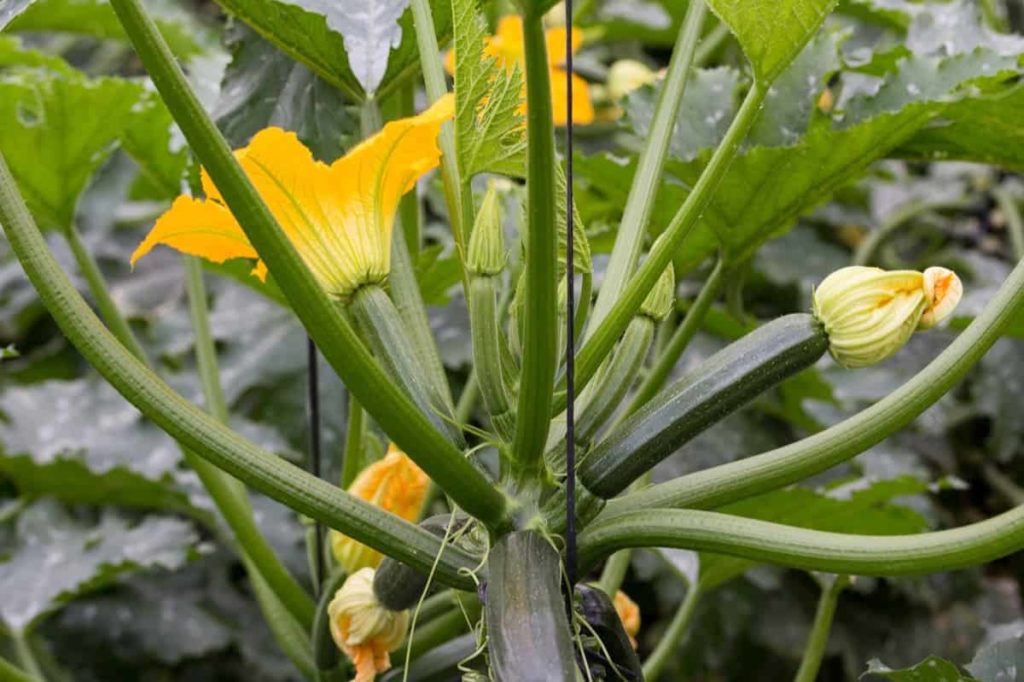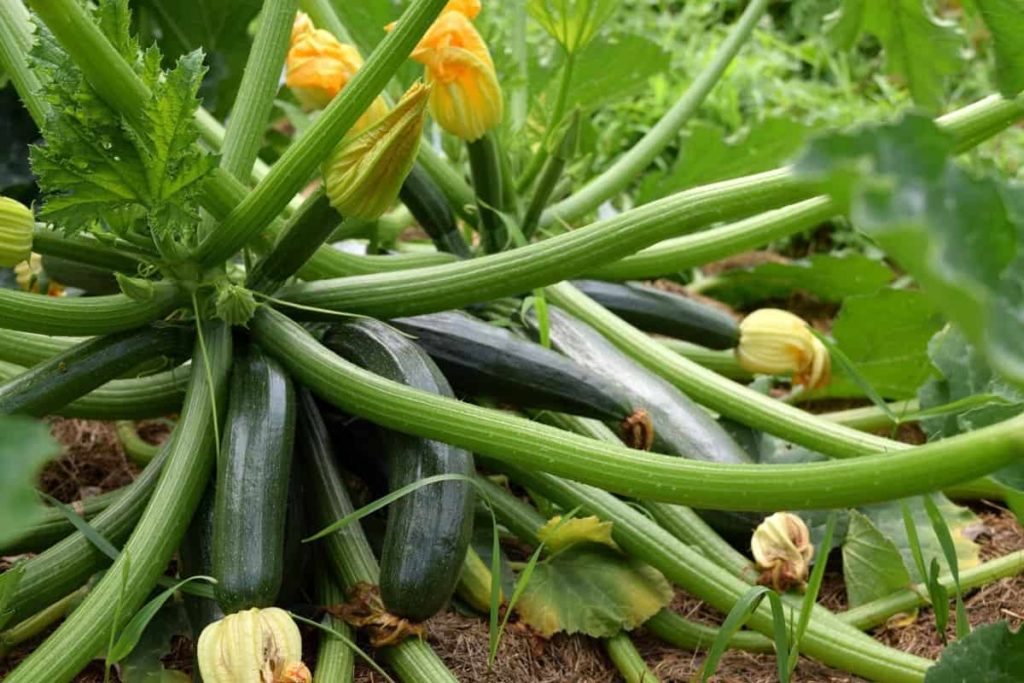Zucchini is the most common vegetable in summer home gardens. Zucchini is a versatile vegetable, but it may face problems during the growing season. When people grow Zucchini, the main problems people face are discoloration, leaf dryness, plant death, and bug infection; and these can be solved using better water and natural fungicides or pesticides.

You can have a huge healthy garden full of Zucchini with the right technique. Some of the problems are human errors, but others are usually out of your control. The sooner you identify them in any way, the better your chances of getting a good crop by the end of the season. Let’s check out the 20 common Zucchini plant problems below.
20 common Zucchini plant problems
Zucchini plants have male and female flowers but fail to set fruit
If you have both male and female flowers but fail to form or drop fruits, there can be several reasons for this. Unsuitable growing conditions, poor water, or inadequate nutrition can cause stress. If some mature fruits have been prepared, but you have not harvested them regularly enough, the plant can drop immature fruits. It regulates the number of fruits produced according to the number it can effectively support.
Solution – The most common reason for the absence of fruit sets is poor or non-existent pollination. Pests like bees pollinate Zucchini plants. A lack of pests often causes a lack of pollination, so they cannot provide their pollination services. There may be only a few insects around due to the cold weather.
You should choose suitable companion plants for your Zucchini to attract pollinators. If you are growing your Zucchini undercover, there may be a problem with the pollinators when it comes to accessing your crops. Leave doors/vents open on hot days to allow them access. And then, select companion plants to draw them in.
Fruit starts rotting or fails to mature
Environmental problems are often responsible if fruits are successfully formed but start rotting or fail to mature. The first step is to consider water and fertility to check if there are any problems. Plants may not be strong enough to sustain fruit production if they are well fed and not well watered. Soil or growing medium may also have problems. It can be very acidic or too alkaline, which will cause problems in the use of nutrients.
Symptom of blossom end rot is Zucchini ends darken. Blossom end rot is not a disease but is caused by calcium deficiency. The soil does not have enough calcium or a low pH, and the plant cannot absorb the available calcium.
Solution – Try adding eggshells and other calcium-rich materials to compost and use it as a mulch around your plants. If it is a recurring problem, liming of soil can help. But you should do this only after a soil test to see if it is needed. Make sure you’re equally watering and not overfertilizing.
Zucchini plants fall over
Another common Zucchini growing problem is when plants start falling as if they are sick or infected. It can happen when fruits start maturing, and their total weight turns down plant stem. Other times, it is an attempt to reach the plant’s most essential resources. Drought may also be due to your adult Zucchini plants falling on each other. Lack of moisture and nutrients in the stem makes them soft and unable to carry the weight of leaves, flowers, and fruits.
Zucchini Gardening For Beginners – How To Start

Solution – Make a small mound around the base of each plant to keep it standing straight. Use stakes when heavy fruits are the cause of the problem. Regularly water plants as they are sensitive to drought. Use slow-release fertilizer to provide nutrients required by plants.
Seeds fail to germinate
If the seeds are too old, they struggle to grow. Seed raising mixture is old or of poor quality. If you have planted your seeds a little too deep, you may find a spray bottle that won’t provide enough moisture to enable the seed to grow. The seed is too old, or you gave too much water.
Solution – Make sure you use a good quality seed enhancement mix and don’t reuse the old mix. If you have planted the seed more than an inch deep, use the soaking technique instead of blurring the soil surface. When the soil is very cold, it can make the seed sterile. One of the big things about Zucchini plants is that they transplant well. Plant in a well-draining seed tray with plenty of sunlight.
Zucchini plants turn yellow
Depending on the variety of the Zucchini plant, the fruits of your vines can vary from dark green to light yellow anywhere. Sometimes when you plant green Zucchini and do not grow them under the right conditions, they turn yellow.
Solution – When your green Zucchini plants turn yellow, there is a fundamental problem caused by one of the elements of appropriate growing conditions, including weather, temperature, and humidity. One of the main reasons the Zucchini is yellow is that they have not been properly pollinated.
When no plant has been properly pollinated, it leads to poor growth in the plant. Plants need to be pollinated by flies or other creatures like them to be able to grow properly. If your areas are experiencing rain or cold weather, your Zucchini plants turn yellow. You may have to wait until the weather improves to solve this problem.
Another best option if you have only a few Zucchini plants is to pollinate them by hand, which can be done by swabbing a small amount of pollen on one of the male flowers to one female flower only. If your Zucchini plants are not flowering or flowering but not producing fruits, that is also the reason. Pollination is completely essential for fruit growth.
The seedlings die-off
Damping-off – At one moment, the seedlings are healthy; the next, they die on the soil surface. Fungi cause it. To avoid dumping off, use a good quality and fresh seed-raising mix. Do not give too much water or crowd too many seeds. Make sure to clean and free of old dirt and debris when you reuse seed-raising pots.
Growing Organic Zucchini In Containers At Home

Drought stress – Insufficient water affects all plants, but it is particularly difficult for Zucchini seedlings. Until the seedlings are well established, make sure to keep the soil moist, but avoid giving too much water. The Zucchini root system is quite large, so water helps it spread and pull as many nutrients as possible.
Zucchini plants are wilting
If you see your Zucchini plants wilting or bending, you’ll need to change something in your garden setup.
Solution – The biggest problem that causes the Zucchini plants to wilt is that they have not received enough water. To prevent wilting, make sure you always water your Zucchini plants well. The ground around them should be moist and watered as deeply as often as necessary to do so. Another way is that plants can wilt or bend because they have been given too much water.
If you find out that you are giving too much water to your plants, give them a chance to soak it all. If they are left in standing water, it gives bacteria and diseases the ability to grow and gain traction. Keeping the soil wet also eventually causes your Zucchini plants to rot from the bottom up.
Pests
Aphids
Aphids and whiteflies are a common problem in the garden. They suck the juice from leaves.
Solution – The best way to deal with them is to choose predatory wildlife for your garden, wildlife such as ladybugs and lacewings will help keep the aphid numbers down.
Vine borers
If healthy Zucchini plants suddenly wilt, look closer to the base of the stem. If you see small holes exuding beige frass, the problem is to feed squash vine borer inside. If several borers feed inside the stem, it will slowly rot and kill the plant.
Growing Zucchini Hydroponically – A Full Guide

Solution – Covering your crop in spring can help prevent this problem. Placing a collar around the base of plants can also help. Consider choosing resistant types if they are too much for you to live in.
Flea beetles
Flea beetles can eat Zucchini as well as other common crops. While they won’t usually kill your plants, they can reduce production.
Solution – The best way to control is to plant companion plants like Radish or Nasturtiums that will act as trap crops.
Cucumber beetles
Cucumber beetles can spread disease. They eat Zucchini and can destroy your crops. They can eat seedlings, holes in leaves and vines, and leave dark marks on your fruits.
Solution – Adult beetles are yellow and black and are relatively easy to detect. When you see them, grab and remove them, use sticky nets, and use cover and hand pollinate where this insect has a problem. Plant Nasturtiums as a trap crop.
Squash bugs
Squash bugs are like smelly insects but thin and small. It can cause yellow spots that eventually turn brown, wilt, and hole. Search for eggs and nymphs under the leaves of your Zucchini. And pick them up whenever you see adults.
Solution – Practice crop rotation and get rid of old vines on your compost pile. Cover plants for the first month or more, or if it’s a problem where you live, delay planting a little. Plant Nasturtiums and Tansy as companion plants. If these are recusal problems, choose the types of resistant Zucchini type.
Cutworms
The cutworms can cut the base of the Zucchini seedlings. These live in the soil. These are quite common in areas where grass lawns have been converted into new vegetable plots.
Solution – Attracting the things that eat them, birds, etc., is a good way to control them. But since they live under the soil most days, you can also stop them by placing a cardboard collar around the base of plants.
Diseases
Alternaria leaf blight
A fungus causes yellow-brown spots with a yellow or green halo that begins on the old leaves of the Zucchini plant. The old leaves are first attacked before spreading into small leaves. The fungus spreads, and leaves are curled, rot, and die if the disease is not treated. Wounds can also appear on fruits.
Zucchini Planting from Seed; Plant Care; Harvest

Solution – Avoid watering the Zucchini plant from the top. Water the plant only on the roots. During the long rain, you may consider covering the Zucchini plants. Cut the affected leaves from a plant near the stem.
Septoria leaf spot
White round spots with brown surroundings are caused by septoria fungus.
Solution–Thrives in moist, humid conditions and low temperatures. When temperatures rise, it is likely to become inactive and return in the fall. It would be best to clean the plant debris on a fallen plant during winter. Trim and dispose of the affected leaves, do not make their compost. Treat with organic copper spray or organic potassium by carbonate spray.
Verticillium wilt
It usually appears in the middle of summer, especially if the temperature is low, as the fungus prefers cold weather. Often the plant wilt during the day and is seen picking up overnight. Half of a plant will be wilted occasionally, and the other half looks normal.
Solution – Thoroughly cleaning garden tools can help prevent the fungus from spreading. There is no cure other than the removal and destroy the infected plants.
Bacterial leaf spot
Small yellow spots on the leaves of the plant. They grow, merge, and create colored spots on the Zucchini fruit if the disease is not treated.
Solution – Rotate crops every two years. Buy disease-resistant Zucchini seed varieties. Copper-based fungicides treatment sprays.
Bacterial wilt
The disease begins with a few wilted leaves without any other apparent cause; it quickly captures the entire Zucchini plant. Both spotted, and striped cucumber beetles spread the disease.
Solution – Keeping weeds away from Zucchini plants can help as they can be the host of cucumber beetle larvae. You can put some dark landscaping clothes around the Zucchini plants to keep weeds away and prevent adult beetles from laying eggs. Once the Zucchini plant is affected, nothing has to be done. Pull the plant to avoid spreading the disease and dispose of it without adding it to the fertilizer.
Growing Zucchini in Containers; Indoors; On the Terrace

Yellow mosaic
Leaves produce yellow mosaic patterns and can look deformed or small than normal. Leaves and Zucchini fruits can also rot.
Solution – Since the aphids spread the disease, be strict about checking them and spraying them with dish liquid and water solution at the first sign. Welcoming insect-eating birds to your garden can also help keep the aphids and other unwanted bug numbers down. There is no cure; dispose of affected plants quickly and do not make compost.
Downy mildew
It is a pathogen that thrives in wet, humid conditions. Most are likely to capture the end of the growing season. The leaves of the Zucchini take the form of being covered in grey dust.
Solution – Water the roots of the plant, not the leaves. Avoid the rush of Zucchini plants, including leaves. You can try organic fungicide. But if the disease has taken over the plant, it’s better to pull it to prevent it from spreading to another plant in the garden. Remove and destroy the entire plant. Do not make compost to avoid spreading disease.
- Broccoli Seed Germination and Selection
- Asparagus Seed Germination and Variety Selection
- Seasonal Flower Gardening: Best Practices for Spring, Summer, Fall, and Winter
- How to Grow Hibiscus from Flower
- Plantation Ideas for Home Decoration: A Beginners Guide
- Flower Garden Designs and Layouts for Beginners
- Planting and Spacing Techniques in Papaya: A Beginner’s Guide
- Growing Gold: Essential Techniques for Planting Pineapples
- How to Make Kalanchoe Plant Bushy: Home Remedies and Solutions
- 11 Reasons Why Your Gardenia is Not Blooming: Home Remedies and Solutions
- Eco Elegance: The Guide to Designing a Drought-Tolerant Landscape
- Gardening on a Slope: Strategies for Hillside Landscaping
- Nourish and Flourish: Top Organic Mulches for Thriving House Plants
- Everything You Want to Know about Indian Mogra Flower: Discover Uses and Growing
- Green Thumb Success: Expert Tips for Cultivating Greenhouse Pumpkins All Year Round
- Maximize Growth & Flavor: The Ultimate Guide to Companion Planting in Herb Gardens
- How to Control Rhododendron Problems Naturally: Home Remedies and Organic Ways to Fix Them
- Natural Magic: The Remarkable Benefits of Cinnamon for Plants
- Best Steps to Revive Dying Tulip with Natural and Organic Treatment
- 10 Reasons Why Your Angel Trumpet is Not Blooming: Remedies and Treatment
- How to Fix Periwinkle Leaf and Flower-Related Problems: Natural Remedies and Solutions
- How to Fix Zinnias Leaf and Flower Problems: Discover Natural and Home Remedies
- Organic Steps to Induce Lemon Tree Flowers: A Comprehensive Guide
- Bloom Booster: Crafting the Perfect Homemade Bougainvillea Fertilizer
- Optimizing Growth: A Guide to Applying NPK Fertilizer for Potted Plants
- 10 Best Homemade Fertilizers for Rubber Plant: DIY Recipes and Application Method
- How to Boost Female Pumpkin Flowers: Effective Steps for More Flowers and High Yields
- Transform Your Indoor Garden: Top Benefits of Pink Salt for Houseplants
- 10 Best Homemade Fertilizers for Peacock Plants (Calathea): Easy DIY Guide
- Unlock Blooms: 9 Reasons Why Your Potted Chrysanthemum is Not Blooming
- 8 Reasons Why Your Potted Hibiscus is Not Blooming: Fix it with Simple Solutions
- Unlock Blooms: 9 Key Reasons Your Potted Frangipani Won’t Flower
- 10 Reasons Why Is My Ice Plant Not Blooming: Remedies and Treatment
- 10 Reasons Why My Potted Hydrangea Not Blooming: Treatment and Remedies
- 10 Reasons Why is My Wisteria Not Blooming: Remedies and Treatment
- 10 Reasons Why is My Goldfish Plant Not Blooming: Remedies and Treatment